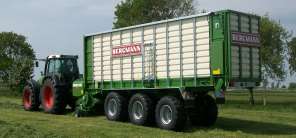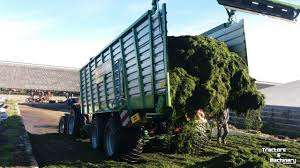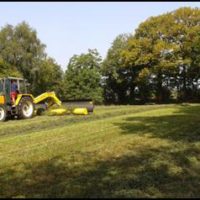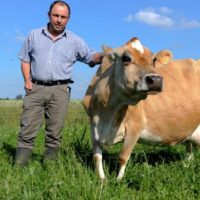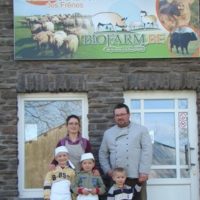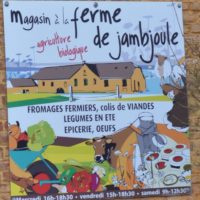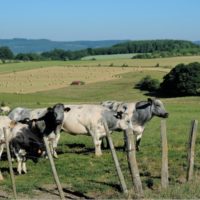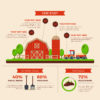Description
Background
- The farm comprises:
- 70 dairy cows, Pie Rouge breed, in a specialized dairy cattle system
- 110 ha UAA
- A grass-based system with 66 ha of main forage area including 35 ha of temporary grassland, 17 ha of permanent grassland and 14 ha of corn silage
- Stocking rate: 2.1 LU/ha Main Forage Area
- Production per cow: 10 600 L of milk
- 2.3 annual work units
The environment of the farm consists of:
- three types of soils: Clay, Limestone and Earthy
- A temperate ocean climate suitable to grass harvesting
Concerning grassland management, the criteria are as follows:
- permanent meadows composed of multi-species mixtures: Perennial rye-grass, Cocksfoot, Fescue and White Clover
- temporary meadows composed of: Perennial Rye-Grass and White Clover or recently a suitable mix for green feeding (practiced by the farmers in autumn and early spring) with long-lasting Rye-Grass varieties, namely, Italian Rye-Grass, White clover and Vetch.
- 60% of the grasslands are exclusively mowed and 23% are exclusively grazed
- 5 cuts per year are carried out on exclusively-mowed grasslands
- type of forage conservation: silage and hay
Continuous grazing is used to manage the dairy cows. The grazing period lasts 6 months per year.
All grasslands are fertilized with up to 120 units of mineral nitrogen.
Grasslands that are exclusively mowed receive an additional 45m3 of clean slurry (0.6 μN).
The technical expertise that innovation implies is one of the greatest farmers’ motivators.
The innovation is part of the farmers’ desire to achieve reasonable goals with a good distribution of the workload while aiming at the food autonomy of the current system.
This innovation was inspired by a trip to Holland in 1983, when Jean-Michel Heurtaux (the father) got on the farm. Since then, the farmer has been working with a system based on growing grass, with a limited amount of corn and many temporary grasslands harvested as silage with a high dry matter content (“haylage”). This system has adapted to the constraints of the farm situation (Natura 2000, watershed, etc.): in a valley, with paddocks on hillsides and along river banks.
In addition, the grazing of dairy cows was maintained despite the setting of a milking robot at the end of 2011, and the old permanent grasslands are gradually being renovated (with a mixture of Hybrid Rye-Grass and Red Clover at first because of its aggressiveness at establishment).
Detailed description
The innovation on this farm is to regularly mow the temporary grasslands at the right stages to optimize the yield and value of the harvested forage.
Its implementation follows several failures in forage harvesting.
The strategy of the breeders is based on a good knowledge of the good forage harvesting stages, thanks to certain natural landmarks and food value analyzes carried out which allows to place themselves for the following years.
The farmers proceed as follows concerning the harvests:
- on temporary grasslands:
- 1st cut end of April
- 2nd cut end of May
- 3rd cut end of June
- 4th cut end of July-early August
- 5th cut late August-early September
- Then grazing by heifers
That means 4 silage cuts and the 5th cut in hay.
- on permanent grasslands:
- 1st cut end of May in hay
- 2nd cut in silage
They use a mower-conditioner that scatters the grass across the cutting width, which avoids haymaking. In general, only one haymaking is done in the spring and no summer.
The farmers swath and harvest with a self-loading machine after 2-3 days of drying on the ground. About 1 ha is harvested per trip thanks to a 30m3 Bergman Royal self-loading wagon.
The different cuts are placed on top of each other in the silos, which makes it necessary to cover and dismantle each silo on average two times.
Results
This innovation initially allowed a better distribution of the workload in the spring and summer with regular harvests, however, but very fast with the use of the self-loading wagons.
In a second step, the innovation allows to harvest grasslands at a young stage, to obtain a better food value. This good control of the harvest stages promotes a good balance of animal diets.
Finally, at equivalent production, ie 29 kg of milk per cow, the quantity of nitrogen correctors has been halved since the introduction of the
innovation. That is 1.5 kg of ”VL 40” instead of 3 kg which would be necessary in conventional ration.
Silage has a high dry matter level (50 to 65%), which promotes ingestion and improves the digestible protein from diet value.
Adoption criteria
The success of this innovation lies in the will of the farmers of an optimum valorization of the grass. This is the first factor in the success of this innovation.
It involves having a good technical expertise in the management of the grasslands and knowing how to appreciate the different stages of the species to harvest the grasslands at its best stage.
Future prospects
Barn drying is planned to go even further in improving the value of harvested forage and in order to save input costs by setting up a methanizer thThe setup of the methanizer is planned for the second half of 2020. The setup of the dryer will be done in a second time.
This innovation can be disseminated by means of:
- grazing promotion events, such as “grass fair”, “Prairiales”, …
- specialized websites
- exchange forum
Threats or fears that may slow down the development of this innovation include:
- the time that it takes; however, the work is more spread over time than with a system mainly based on corn silage, but there are plenty of grass crops to be expected: in spring and summer, “every month we must mow”.
- potential modifications of harvest stages linked to global warming; harvests that may interfere with other farm work. A drier climate in summer could also penalize the regrowth of the grass after the harvests and thus limit their number.at is currently under study.

